Steel has a key role to play in the government’s drive for greater use of offsite construction techniques. This CPD will look at the structural steelwork construction process, with a focus on established offsite processes and practices
CPD CREDITS: 60 MINUTES
DEADLINE: 12 OCTOBER 2018
For more information about Assemble Media Group’s CPD distance-learning programme, click here
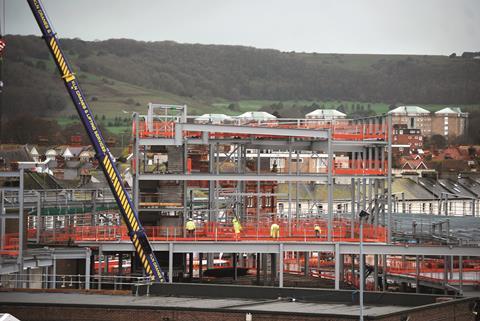
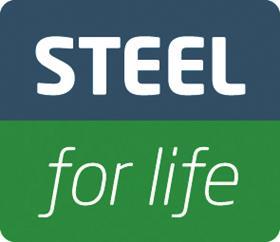
INTRODUCTION
The government and the Construction Leadership Council have earmarked offsite manufacturing as a route to increase construction productivity and reduce costs. A faster on-site construction programme would mean that government construction targets could be met more easily and the programme would be less affected by adverse weather, while a shorter on-site programme is also more cost-effective.
Designers and specifiers have long recognised the benefits that steel offers the construction sector, noting that steel framing is the original offsite framing material.
Fabrication of individual steel pieces takes place offsite under controlled, highly regulated, safe factory conditions where the use of digital design and leading-edge fabrication systems deliver precision-engineered components with minimum waste. Steel components are further preassembled or fabricated into modules either offsite or at the site at a low level.
Steel structures are often prototyped or trial built offsite to ensure a perfect fit when the fabricated steel modules undergo final assembly on-site. This means that the majority of the value-add for structural steel occurs offsite – in some cases up to 90%.
This CPD will look at the structural steelwork construction process with a focus on established offsite processes and practices, alongside the benefits provided.
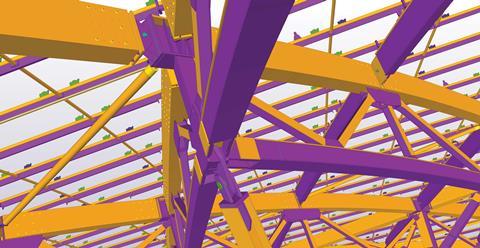
Structural steel procurement
In responding to the tender request, the steelwork contractor gets a price for the rolled steel they need to buy, either directly from the UK mill or from one of the UK’s many steel stockholders or distributors. Once the job is secured by the UK steelwork contractor, the steel will be ordered. When the steelwork contractor wins a contract, this is based on a set of “estimate drawings”.
On an average contract, the lead time (time before the steel is required on site) may be 10 working weeks. These weeks are for the steelwork contractor to design the connections, detail the steelwork (drafting the components, working out how the smaller lots go together, etc), issue the drawings/model to the works, order and receive the steel, fabricate the steel and deliver the steel to the construction site.
The client’s consulting engineer will normally take the architect’s 3D model of the building and provide the structural layout and member sizes. Additional information such as the design forces in the connections may be added for later use by the steelwork contractor. This model is then transposed into structural and detailing information by the steelwork contractor using well-known software packages.
In many building projects, the main contractor will manage a building information management (BIM) system into which all the key parties (and especially the steelwork contractor and other specialist subcontractors) will provide their detailing information to enable the BIM model to be updated and act as a comprehensive source of geometric building data for all of the construction team.
The steelwork contractor will create details of all the connections based on the forces specified by the consulting engineer and may employ their own consulting engineer for specialist design and temporary works tasks.
Once the job has been confirmed, the steel will typically be procured through the stockholder or distributor route. Orders have to be placed earlier for steel to be bought directly from the mill. If the steel is an unusual grade it might need to be rolled specially or ordered through one of the established routes.
Some products might also need to be purchased through, or fabricated by, specialist suppliers, for example cellular beams (beams with large holes in them to accommodate services), asymmetric beams or plate girders.
Steelwork contractors receive changes to the drawings routinely from the consulting engineer and the main contractor, which they have to deal with as efficiently and as safely as possible. The best way to deal with the changes is by addressing them offsite in the factory before the steel goes to the construction site.
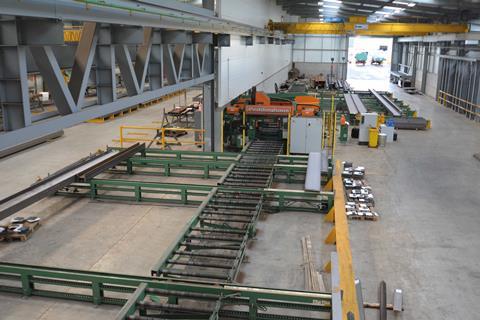
Design
The steel construction sector has been using 3D design software for more than a quarter of a century and is well versed in the benefits and efficiencies it provides to manufacturing and construction programmes. Today’s computer software is integral to the design, fabrication, erection and everyday operational processes at most steelwork contractors’ facilities.
Software is interwoven into each stage of the steel fabrication process, supporting activities such as knowledge and bid management, project planning, frame analysis, connection design, 3D modelling, BIM co-ordination and the fabrication process itself.
During the design phase, the structural steel will be modelled to facilitate fabrication. Materials resource planning (MRP) software then processes the bill of materials data from the model, which is used for procurement of materials, manages data to drive automated cutting and fabrication machinery and plans logistics, as well as piece weights for crane planning. MRP software can also be used to monitor progress of fabrication by capturing data about each part as it passes through the different fabrication processes.
The structural steelwork sector is also seeing the adoption of modern scribe marking technologies. Software can allow for full or partial contours to be scribed directly onto the steel to indicate the position of the parts that need to be welded, saving valuable time and minimising errors. In addition, information can be marked on the steel to indicate quality, traceability, welding information and assembly details.
Fabrication
Once the 3D model and the steel are received in the factory, fabrication will commence. Steelwork fabrication processes include:
- Design and detailing of connections and attachments;
- Cutting to length and chamfering of beams, columns and bracing;
- Drilling of holes for bolts;
- Welding is a core activity in the fabrication factory – it is used to prepare joints for connection on-site and for the attachment of other fixtures and fittings;
- Blast cleaning and painting steelwork;
- Attachment of fitments for installation and protection, eg edge protection;
- Manufacture and attachment of secondary components, such as cleats, shims and bolts and lifting lugs;
- Curving of members, forming of openings – often carried out by specialist companies;
- In some cases, partial concrete encasement and shear connector welding in the factory;
- Scheduling for delivery on a “just-in-time” basis and transport from the fabrication workshop to the construction site;
- Design of temporary works.
Advances in quality and productivity in the steel construction sector are largely due to developments in fabrication machinery. The manufacturers of steelwork fabrication equipment have invested heavily in research and development to produce the technological advances required by today’s steel construction sector.
Manufacturers of steel fabrication equipment work closely with steelwork contractors planning the factory design and layout with real-time simulation to find the best flow of material and maximise production based on required output through the use of advanced simulation software.
Computer numerically control (CNC) machinery is the standard today and is integrated into each stage of the steel fabrication process. The process may vary between each steelwork contractor but will generally commence with the transfer of 3D model information from the design office to the equipment in the factory.
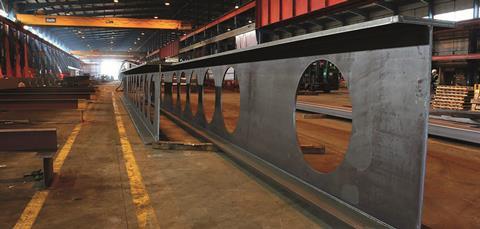
Benefits of offsite construction
The benefits of offsite construction have long been appreciated by designers, contractors and owners of buildings. Being fabricated offsite in closely controlled factory conditions means everything is produced to high standards of accuracy and defect free – effectively “right first time”.
Factory-based manufacture allows full integration with the latest computer-aided design and computer-controlled production developments. Digital design for manufacture and assembly, including full BIM Level 2, has additionally created new skills in the sector.
Many processes are fully or at least semi-automated, with industrial robots routinely being used in fabrication factories for operations such as welding. Coatings including intumescent paints can also be applied offsite – indeed the factory application of this type of coating reduces the risk of delay to following trades. It also helps minimise the on-site construction programme.
Offsite manufacture of constructional steelwork results in waste being minimised beyond what can be achieved with alternative materials.
There are other advantages. With on-site work reduced largely to speedy assembly, using structural steelwork means local communities are spared much of the noise and dust inevitably generated by other construction work. Logistical benefits are also derived from steelwork’s ability for timed or just-in-time delivery as dictated by site requirements. The erection of steelwork direct from the just-in-time delivery lorry minimises the requirement for set-down and storage areas, which can be important where space is at a premium.
Additionally, fewer people are required on site, which helps to mitigate issues around skills shortages, and improves on-site safety. The need to work at height is reduced due to the majority of the work taking place offsite, which also provides a skills and safety benefit.
The stable, long-term nature of jobs in a steel fabrication factory assists in the training of a specialist workforce. Such skills development both motivates the workforce and increases the efficiency of offsite steel construction. Offsite steel construction also benefits communities that might not profit directly from investment in construction or infrastructure, for instance some areas outside London and the South, but ongoing manufacturing employment can bring stability and growth to such areas.
Site safety is promoted by offsite production, as manufacture under factory-controlled conditions is inherently safer than is possible under typical construction site conditions. On-site operations are in the hands of highly-qualified site erection teams, who are specialists and are obliged to hold recognised qualifications.
With so much work carried out offsite, the on-site construction programme is reduced and the build programme is relatively unaffected by adverse weather conditions. Steel can be delivered to site as and when it is required, reducing the need for potentially hazardous on-site storage.
Examples of offsite construction incorporating mechanical and electrical services
Already, many steel structures have mechanical and electrical services (M&E) incorporated offsite – some examples include motorway gantries with the lighting and signage already fitted, transfer bridges for large manufacturing plants, and even the risers in high-rise buildings.
Motorways gantries for Highways England
Steelwork contractors receive designs from Highways England that have the M&E incorporated into the BIM model. The steelwork contractor fabricates the gantry offsite, in their factory. The fabricated gantry is then moved to a separate part of the steelwork contractor’s manufacturing facility and the M&E contractor incorporates the electrical/communications cabling and junction boxes on the gantry bodies.
For efficiency, the M&E contractor is only called to the manufacturing facility when a sufficient number of structures have been completed. The steelwork contractor then transports the motorways gantries to site and installs them in approximately 30 minutes, after which the signage and lights are fitted. Pre-installation of electrical/communications cabling and junction boxes on the gantry bodies allows greater control, provides safety benefits and yields both time and cost savings.

London Bridge station redevelopment
Construction of the London Bridge station redevelopment included 1,200 prefabricated steel cassettes installed by Severfield, with each one a bespoke unit due to the changing rooftop geometry. They are 9m long by 3m wide and fabricated from galvanized I-section rafters.
After assembly at Severfield’s Bolton and Dalton factories, the project’s M&E contractor installed the services and the cladding contractor formed the cassette’s individual canopy roof. The completed cassettes were then delivered to site in loads of up to three units per truck and, because they only weighed 2.5 tonnes each, were lifted into place by one of the site’s tower cranes.

How to take this module
Assemble Media Group’s CPD distance-learning programme is open to anyone seeking to develop their knowledge and skills. Each module also offers members of professional institutions an opportunity to earn between 30 and 90 minutes of credits towards their annual CPD requirement.
This article is accredited by the CPD Certification Service. To earn CPD credits, read the article and then click the link below to complete your details and answer the questions. You will receive your results instantly, and if all the questions are correctly answered, you will be able to download your CPD certificate straight away.
CPD CREDITS: 60 MINUTES
DEADLINE: 12 OCTOBER 2018
Privacy policy
Information you supply to Assemble Media Group Limited may be used for publication and also to provide you with information about our products or services in the form of direct marketing by email, telephone, fax or post. Information may also be made available to third parties. Assemble Media Group Limited may send updates about Building CPD and other relevant Assemble Media Group Limited products and services. By providing your email address you consent to being contact by email, telephone, fax or post by Assemble Media Group Limited or other third parties. If at any time you no longer wish to receive anything from Assemble Media Group Limited or to have your data made available to third parties, contact the Data Protection Coordinator at building@building.co.uk. View our full privacy policy here.

















No comments yet